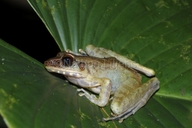|
Meristogenys maryatiae Matsui, Shimada & Sudin, 2010
Maryati’s torrent frog | family: Ranidae genus: Meristogenys |
| Species Description: Matsui M, Shimada T, Subin A 2010 A new species of Meristogenys (Amphibia, Anura, Ranidae) from Sabah, Borneo. Zool Sci 27:61-66. | |
 © 2012 Nathan Litjens (1 of 1)
|
|
|
|
Description Diagnosis: Maryati’s torrent frog is identifiable as a member of the Ranidae family because of its large hind legs, tympanum, toe pads, and the presence of a dorsolateral ridge. This specific species is distinct from other members of the genus Meristogenys because it is especially small. Specifically, M. poecilus and M. whiteheadi are two species that can be separated because of their larger size. Meristogenys maryatiae also has distinct dorsal dark spots, which separates it from all others, except M. amoropalamus and M. orphnocnemis. Meristogenys maryatiae has a golden, unicolored iris, which differentiates it from the bi-colored iris found in M. amoropalamus and M. jerboa. Meristogenys amoropalamus also has more foot webbing. Meristogenys orphnocnemis has ventral pigmentation on its tibia surface and less foot webbing. Meristogenys phaeomerus and M. whiteheadi have dark brown coloration on the posterior of its thighs with small light spots vs. the dark brown and cream color in M. maryatiae. The wider headband and larger eyes of M. macrophthalmus differentiate them from our focal species. Meristogenys maryatiae is most similar to M. jerboa (Matsui et al. 2010) For more description, comparisons, coloration in life, variation, and larval description, please see Matsui et al. 2010. Distribution and Habitat Country distribution from AmphibiaWeb's database: Malaysia Malaysian region distribution from AmphibiaWeb's database: Sabah
Life History, Abundance, Activity, and Special Behaviors There have only been a few females seen and it is described as a cryptic species (Matsui et al. 2010). This species is semi-aquatic and is only found along mountain torrents, which they use for food, shelter, and reproduction (Matsui et al. 2010). The breeding season is in late summer, most likely around August, as two females that were collected in late July had very mature eggs, indicating that breeding season was soon. There have also been recorded mating calls in late August, which sounded similar to that of M. jerboa. Many males have also been found in summer months at night surrounding the riverbeds and stream, but very few females have been seen (Matsui et al. 2010). Meristogenys maryatiae appears to be oviparous, with the eggs having a black animal pole and the vegetal pole being pale yellow brown. There doesn’t appear to be any parental care, but more observations are needed (Matsui et al. 2010). The tadpoles are usually found clinging to rocks in the rapidly moving streams, typically in shallower waters that have a depth of less than 20 cm (Matsui et al. 2010). Trends and Threats Relation to Humans Possible reasons for amphibian decline General habitat alteration and loss Comments PHYLOGENETIC RELATIONSHIPS: Meristogenys maryatiae was initially recognized as a unique species based on morphology. However, analysis of 12S rRNA and Cyt b mitochondrial DNA and POMC, Rag–1, and rhodopsin nuclear DNA indicate it is closely related to M. whiteheadi, M. orphnocnemis, and M. amoropalamus. However, the analysis was unable to determine a sister-group relationship (Matsui et al. 2010). ETYMOLOGY: The species was named after Professor Datin Mohamad Maryati who is an eminent entomologist who did a lot of herpetological work in the State of Sabah for the Institute of Tropical Biology and Conservation (Matsui et al. 2010).
References
IUCN SSC Amphibian Specialist Group (2018). "Meristogenys maryatiae." The IUCN Red List of Threatened Species 2018: e.T79096177A123533800. https://dx.doi.org/10.2305/IUCN.UK.2018-1.RLTS.T79096177A123533800.en. Accessed in February 2022. Matsui, M., Shimada, T., Sudin, A. (2010.) “A new species of Meristogenys (Amphibia, Anura, Ranidae) from Sabah, Borneo.” Zoological Science 27(1): 61-66. [link] Originally submitted by: Claire Grazela,Michael Gago, Jasmin Johl (2022-07-22) Description by: Claire Grazela,Michael Gago, Jasmin Johl (updated 2022-07-22)
Distribution by: Claire Grazela,Michael Gago, Jasmin Johl (updated 2022-07-22)
Life history by: Claire Grazela,Michael Gago, Jasmin Johl (updated 2022-07-22)
Trends and threats by: Claire Grazela,Michael Gago, Jasmin Johl (updated 2022-07-22)
Relation to humans by: Claire Grazela,Michael Gago, Jasmin Johl (updated 2022-07-22)
Comments by: Claire Grazela,Michael Gago, Jasmin Johl (updated 2022-07-22)
Edited by: Ann T. Chang (2022-07-22) Species Account Citation: AmphibiaWeb 2022 Meristogenys maryatiae: Maryati’s torrent frog <https://amphibiaweb.org/species/7578> University of California, Berkeley, CA, USA. Accessed May 19, 2025.
Feedback or comments about this page.
Citation: AmphibiaWeb. 2025. <https://amphibiaweb.org> University of California, Berkeley, CA, USA. Accessed 19 May 2025. AmphibiaWeb's policy on data use. |




 Map of Life
Map of Life